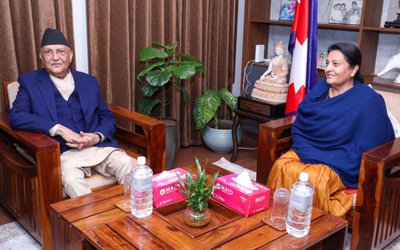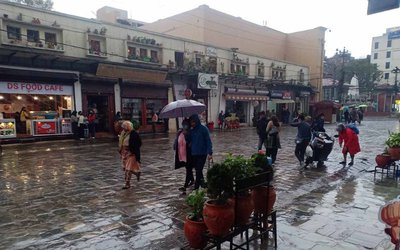
Technically, a wicked problem is one where contending parties cannot even agree on defining “what the problem is”, let along agreeing on solutions. It cannot be solved through comfortable knowledge of textbook engineering or easy market economics which probably got us into the mess in the first place, requiring instead “uncomfortable knowledge” that challenges conventional thinking. Eventually, what would emerge is a “clumsy solution” that does not fully please all the contending views, requires many compromises from all opposing sides, but allows awkward moving forward with piecemeal engineering, both social and physical.
Kathmandu’s newly elected independent mayor Balen Shah, in addition to the myriad other challenges he has to cope with, has to handle precisely such a wicked problem that is urban flooding.A freak 15-minute thunderstorm turns Kathmandu’s streets into raging torrents that sweep away motorcyclists, minivans and even unsuspecting school children to their death. It is easy and fashionable to blame climate change for high intensity rainfall – and thus wash away any moral culpability the delinquent authorities, municipal and national, have to bear for this problem. Unfortunately, while climate change is going to give us increased intensity and frequency of both floods and droughts in the decades ahead, the root of the problem lies in the past years of here-and-now of mal-development that cancerous urban growth has seen, beginning with the last decade Panchayat system after the 1980 national referendum and accelerating thereafter.
North-East Kathmandu on the left (eastern) bank of Dhobi Khola is a classic example, much of it the catchment of its sister tributary Chakhunja Khola (now paved over for a main road with the river forced into 48-inch hume pipes!). It saw itself transformed from green paddy fields to packed, cheek-by-jowl housing development in these four decades. The area from Chabel Chowk on the Ring Road to Kopan monastery to the north is today as, if not more, densely packed as core city areas of Patan or Bhaktapur. Comprising of Kathmandu municipality’s wards 6 and 7, Budhaneelkantha’s wards 10, 11 and 12, as well as Gokarna’s ward 9, it has at least thirty thousand houses by eyeball estimates and a population close to two hundred thousand.

If one assumes each house has cost on an average thirty million rupees to build (and they are fairly well-built fancy houses!), we are talking nearly a trillion rupees of private investments alone! And if one adds to that public utility services of roads, electricity, telephone and internet cables, water supply etc., the number heads towards the astronomical. And if you multiply the replication of Dhobi Khola urbanization across Kathmandu valley several times – from Thankot to Sanga Bhanjyang, and Saankhu to Chapagaon, it is impossible to imagine that Nepal is a poor country!! And it is also very difficult to believe that just over thirty years ago, much of these areas were lush green rice fields!
What the third decade of Panchayat failed to do, i.e., decentralize development to the cities and districts outside Kathmandu valley, multiparty system since 1990 failed to even more dramatically. Jobs, schools for children and hospitals for the sick were all concentrated in the capital with rent-seeking politicians adept at centralized patronage dispensing. It became imperative for people outside Kathmandu hoping to advance their careers or businesses to have a toe-hold, a roof over their heads, in the city’s vicinity. Maoist insurgency since 1996 greatly accelerated the process with anyone who was anybody in the districts feeling highly insecure and thus needing to relocate to Kathmandu for safety. Politicians in cahoots with land speculators (jagga plotting dalals, in Nepali) were quick to take advantage of this new-found demand.
This Dhobi Khola area is the battleground constituency of Kangress’s Gagan Thapa and the UML’s Rajan Bhattarai, both leading icons of their own parties. In discussions with locals about development initiatives, especially the resettling of their followers and providing them perks, the name of president Bidhya Bhandari also comes up as this was the electoral constituency of her late husband Madan Bhandari. So too do pop up names of former vice-president Paramananda Jha, RPP leader Buddhiman Tamang and many more. Denizens of this settlement include current and retired judges, chief engineers, director generals, senior journalists, aid agency officers, NGO stalwarts and many more such luminaries. Unfortunately, with the exception of one lone Tol Sudhar Samity in Kathmandu #6, they are all highly individualized with little sense of community cohesion; and having bought their plot of land from some broker, have bargained for whatever public service such as roads or drains or water supply they could muster mostly at an individual level.

This is where their current woes stem from. Having never considered drainage as a collective public good but only as one of individual convenience, they find that, having built over rice fields, paved over rivulets and natural drainage channels for streets, and blocked spring outlets, streets turn into raging torrents even during normal thunder storms. Their ground floors are regularly flooded as Chakhunja river struggles to find its outlet to Dhobi Khola.
And the Nepali state as well as municipal/VDC authorities too having failed on this count as departments such as survey, roads, irrigation etc. have turned a blind eye to public land and riverine zones being criminally privatized and sold. (It is said the Survey Department refuses to give out cadastral maps of this area on application request as that would open up a can worms of the corruption therein!) If this is the state of surface flow, there is an even greater danger lurking in its groundwater. Because of individual blocking of spring outlets, groundwater and soil pressure is building up in unlikely of places, pointing to possibilities of massive slope failure and subsidence, especially if earthquake tremours were to take place during the rainy season leading to high liquefaction.
Individualized approach to public goods such as drainage and roads – coupled with competitive political patronage – has led to the anarchic situation of multiple agencies working at cross-purposes to build drains. Chakhunja Khola has been forced into hume pipes totally incapable of handling thunderstorm floods with multiple connections in the upper reaches and inadequate capacity at the lower end by the time its main stem reaches Dhobi Khola. And working on short specific stretches at the behest of powerful individuals with no coordination whatsoever have been many government bodies whose professional technical staff should have known better: the Melamchi project, Irrigation Ministry’s Department of Water Induced Disaster, Kathmandu Valley Development Authority, and Local Development Ministry. Strangely, neither Kathmandu nor other municipalities have invested much in drainage work, except for individuals personally favoured by former mayor of Kathmandu.
While individual households have come up with creative and much-needed solutions – from raised dykes in front of their shops and house entrances, plugs for drains to prevent backflow of sewerage, roof water not allowed to spill into the yard but collected into wells – they are hardly adequate to solve the problem’s totality. But given the individualized nature of the settlement, it would also not be wise for mayors of Kathmandu, Budhaneelkantha and Gokarna to impose any planned solution. Indeed, there are already rumblings of discontent and preparations to go to court against neighbours across the block! Better would be for them to facilitate more Tol Sudhar Samities to first discuss this wicked problem among themselves. These civic bodies (with municipal leadership help) would need to find pointers from uncomfortable knowledge of floods and hydrogeology, land taxation/equitable household contributions, anthropological understanding of institutional evolution of public endeavors etc. Only then could they arrive at outlines of clumsy solutions before municipalities or government bodies could provide them practical relief measures. Failing that, it would be more money literally going down the drain!

Dipak Gyawali
Gyawali is Pragya (Academician) of the Nepal Academy of Science and Technology (NAST) and former minister of water resources.
- Re-Thinking Democracy: Why South Asians Are worried
- Mar 17, 2025
- Nepal’s Governance Mired In Endemic Corruption
- Feb 20, 2025
- What Might The Age Of Trump Look Like?
- Jan 22, 2025
- Kathmandu Dialogue With Dugin
- Dec 25, 2024
- Bioregionalism Satsang
- Sep 27, 2024














